ITC508 Assignment 2: Elaboration Phase for Collin's ATM System Design
VerifiedAdded on 2024/05/21
|20
|2782
|319
Report
AI Summary
This assignment focuses on the elaboration phase of Collin's ATM system, beginning with the identification of both functional and non-functional requirements. It then presents a use case model derived from these requirements, providing detailed explanations of each use case. A class diagram is designed to represent the system and its subsystems, followed by a discussion of key assumptions. The assignment also outlines the Software Development Life Cycle (SDLC) activities involved in the ATM's development, including environment description, application component design, user interface considerations, database implementation, and software methods. The document concludes with a summary of the ATM's technical requirements and operational considerations.
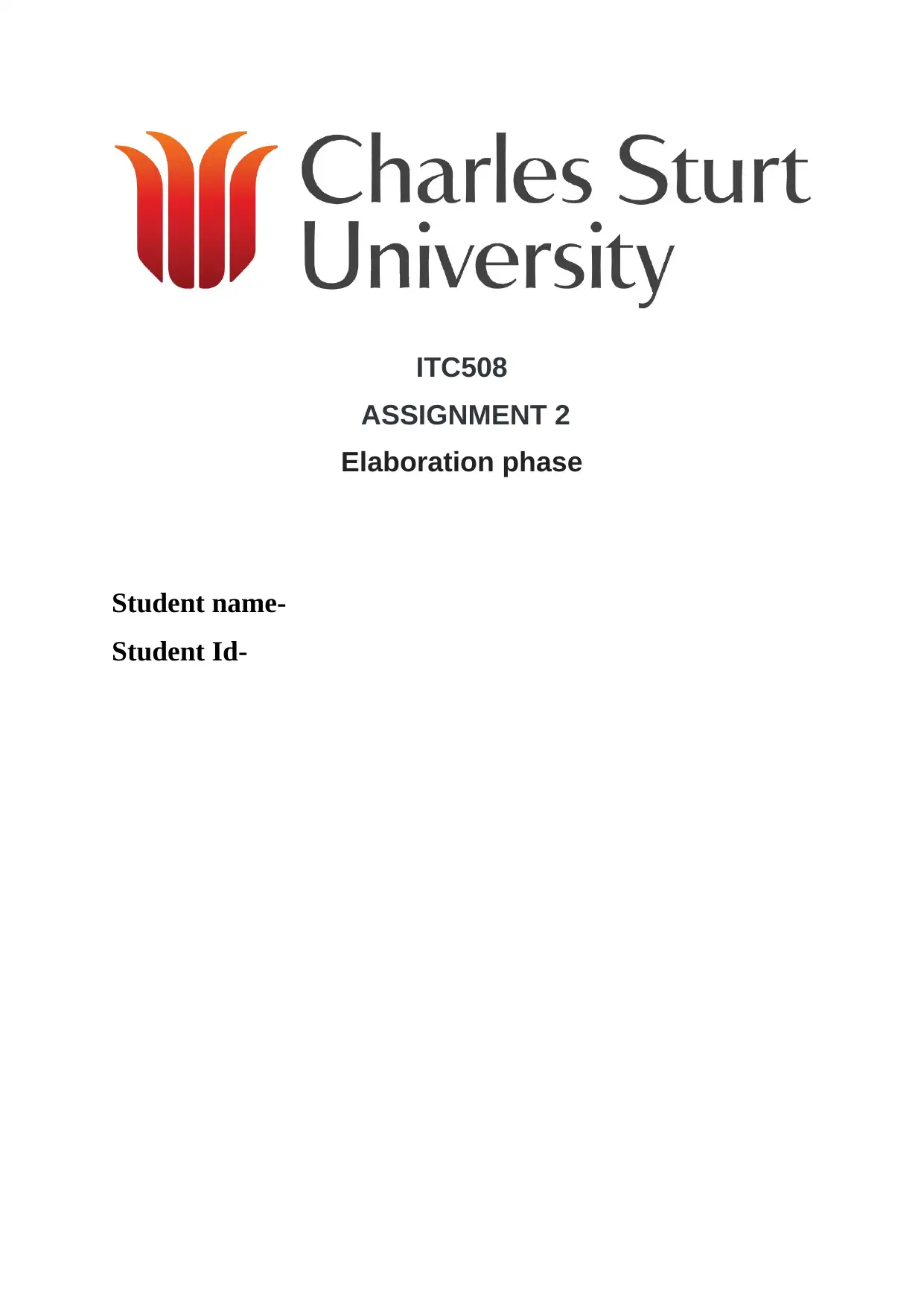
ITC508
ASSIGNMENT 2
Elaboration phase
Student name-
Student Id-
ASSIGNMENT 2
Elaboration phase
Student name-
Student Id-
Paraphrase This Document
Need a fresh take? Get an instant paraphrase of this document with our AI Paraphraser
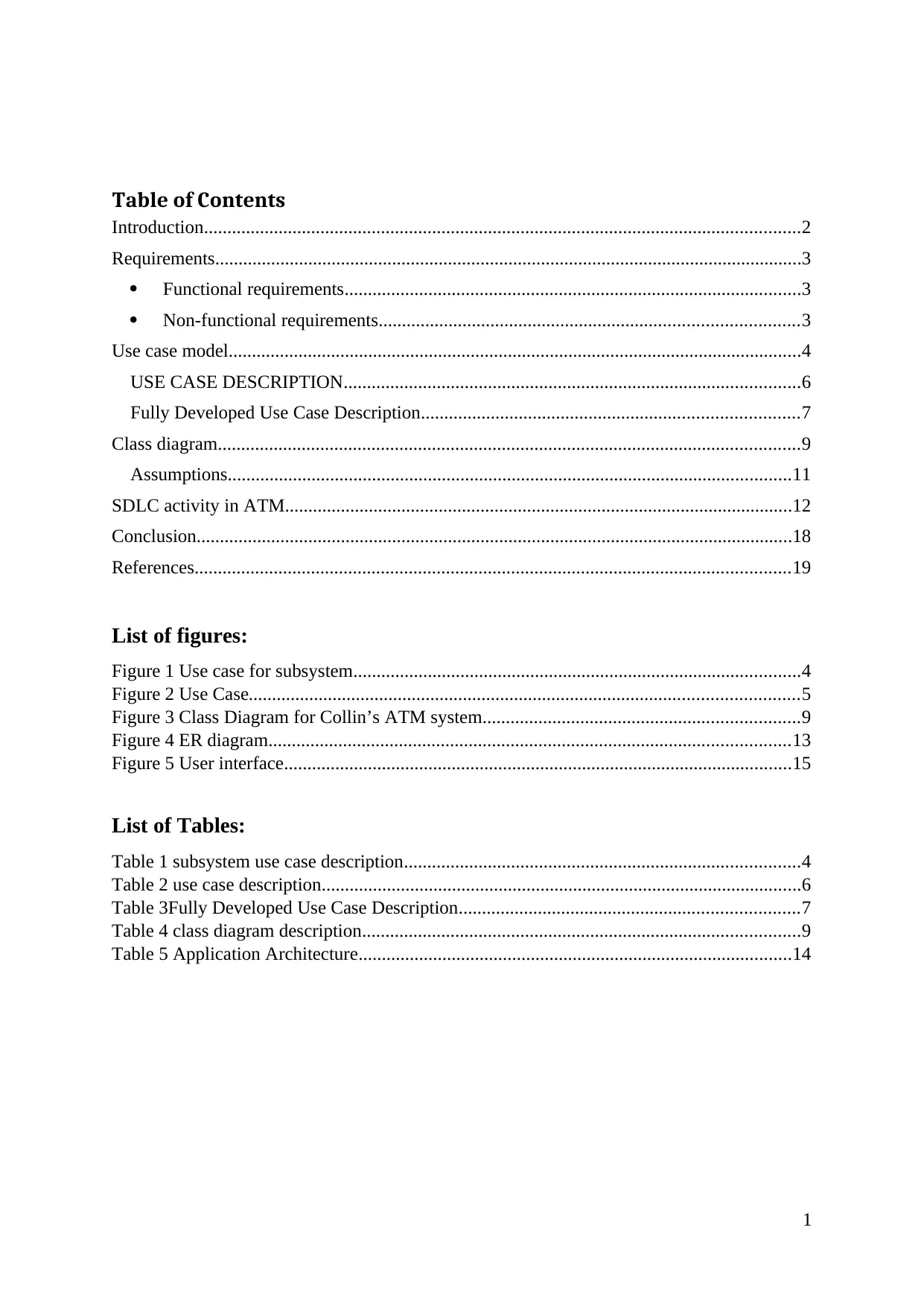
Table of Contents
Introduction................................................................................................................................2
Requirements..............................................................................................................................3
Functional requirements..................................................................................................3
Non-functional requirements..........................................................................................3
Use case model...........................................................................................................................4
USE CASE DESCRIPTION..................................................................................................6
Fully Developed Use Case Description.................................................................................7
Class diagram.............................................................................................................................9
Assumptions.........................................................................................................................11
SDLC activity in ATM.............................................................................................................12
Conclusion................................................................................................................................18
References................................................................................................................................19
List of figures:
Figure 1 Use case for subsystem................................................................................................4
Figure 2 Use Case......................................................................................................................5
Figure 3 Class Diagram for Collin’s ATM system....................................................................9
Figure 4 ER diagram................................................................................................................13
Figure 5 User interface.............................................................................................................15
List of Tables:
Table 1 subsystem use case description.....................................................................................4
Table 2 use case description.......................................................................................................6
Table 3Fully Developed Use Case Description.........................................................................7
Table 4 class diagram description..............................................................................................9
Table 5 Application Architecture.............................................................................................14
1
Introduction................................................................................................................................2
Requirements..............................................................................................................................3
Functional requirements..................................................................................................3
Non-functional requirements..........................................................................................3
Use case model...........................................................................................................................4
USE CASE DESCRIPTION..................................................................................................6
Fully Developed Use Case Description.................................................................................7
Class diagram.............................................................................................................................9
Assumptions.........................................................................................................................11
SDLC activity in ATM.............................................................................................................12
Conclusion................................................................................................................................18
References................................................................................................................................19
List of figures:
Figure 1 Use case for subsystem................................................................................................4
Figure 2 Use Case......................................................................................................................5
Figure 3 Class Diagram for Collin’s ATM system....................................................................9
Figure 4 ER diagram................................................................................................................13
Figure 5 User interface.............................................................................................................15
List of Tables:
Table 1 subsystem use case description.....................................................................................4
Table 2 use case description.......................................................................................................6
Table 3Fully Developed Use Case Description.........................................................................7
Table 4 class diagram description..............................................................................................9
Table 5 Application Architecture.............................................................................................14
1
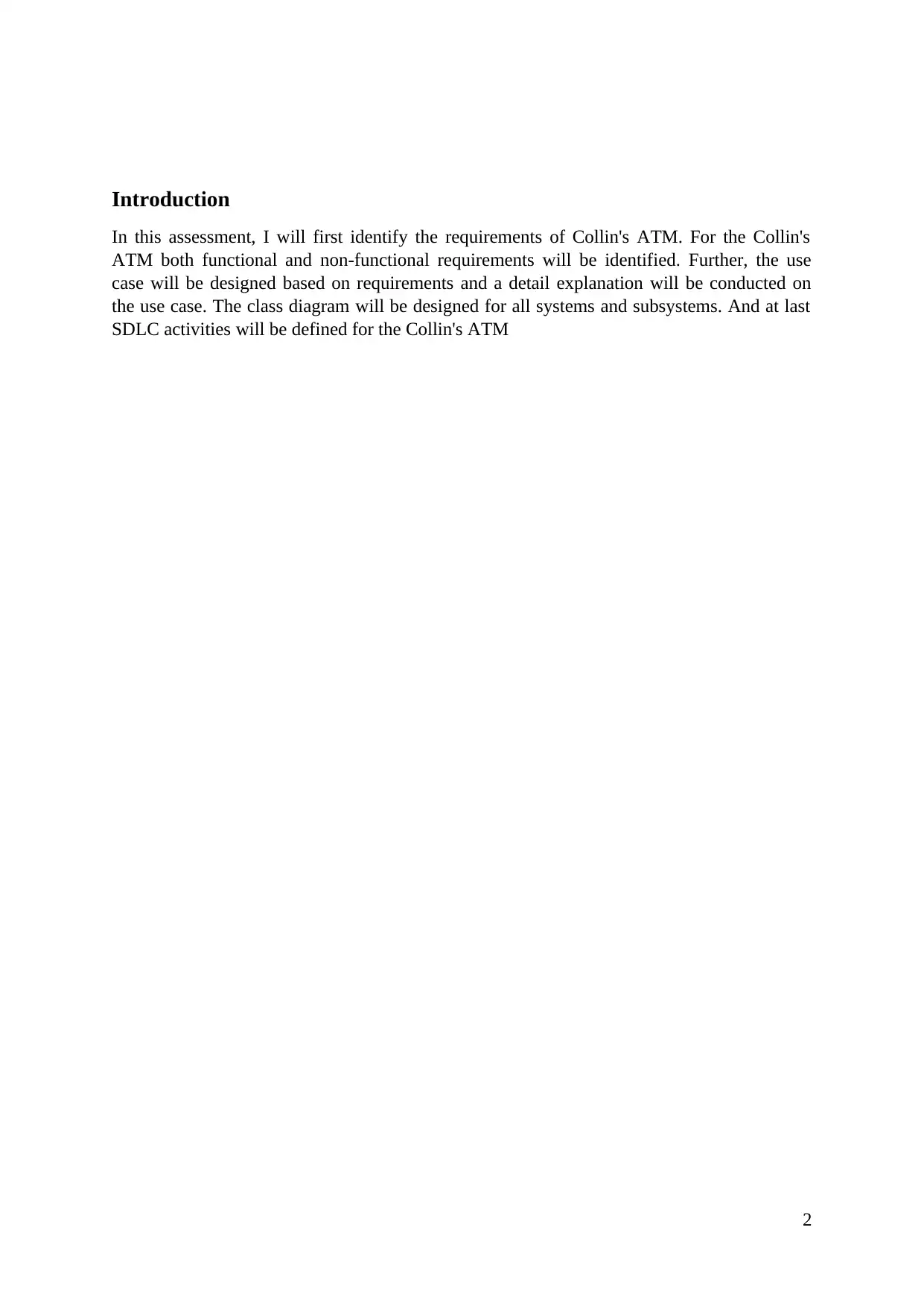
Introduction
In this assessment, I will first identify the requirements of Collin's ATM. For the Collin's
ATM both functional and non-functional requirements will be identified. Further, the use
case will be designed based on requirements and a detail explanation will be conducted on
the use case. The class diagram will be designed for all systems and subsystems. And at last
SDLC activities will be defined for the Collin's ATM
2
In this assessment, I will first identify the requirements of Collin's ATM. For the Collin's
ATM both functional and non-functional requirements will be identified. Further, the use
case will be designed based on requirements and a detail explanation will be conducted on
the use case. The class diagram will be designed for all systems and subsystems. And at last
SDLC activities will be defined for the Collin's ATM
2
⊘ This is a preview!⊘
Do you want full access?
Subscribe today to unlock all pages.

Trusted by 1+ million students worldwide
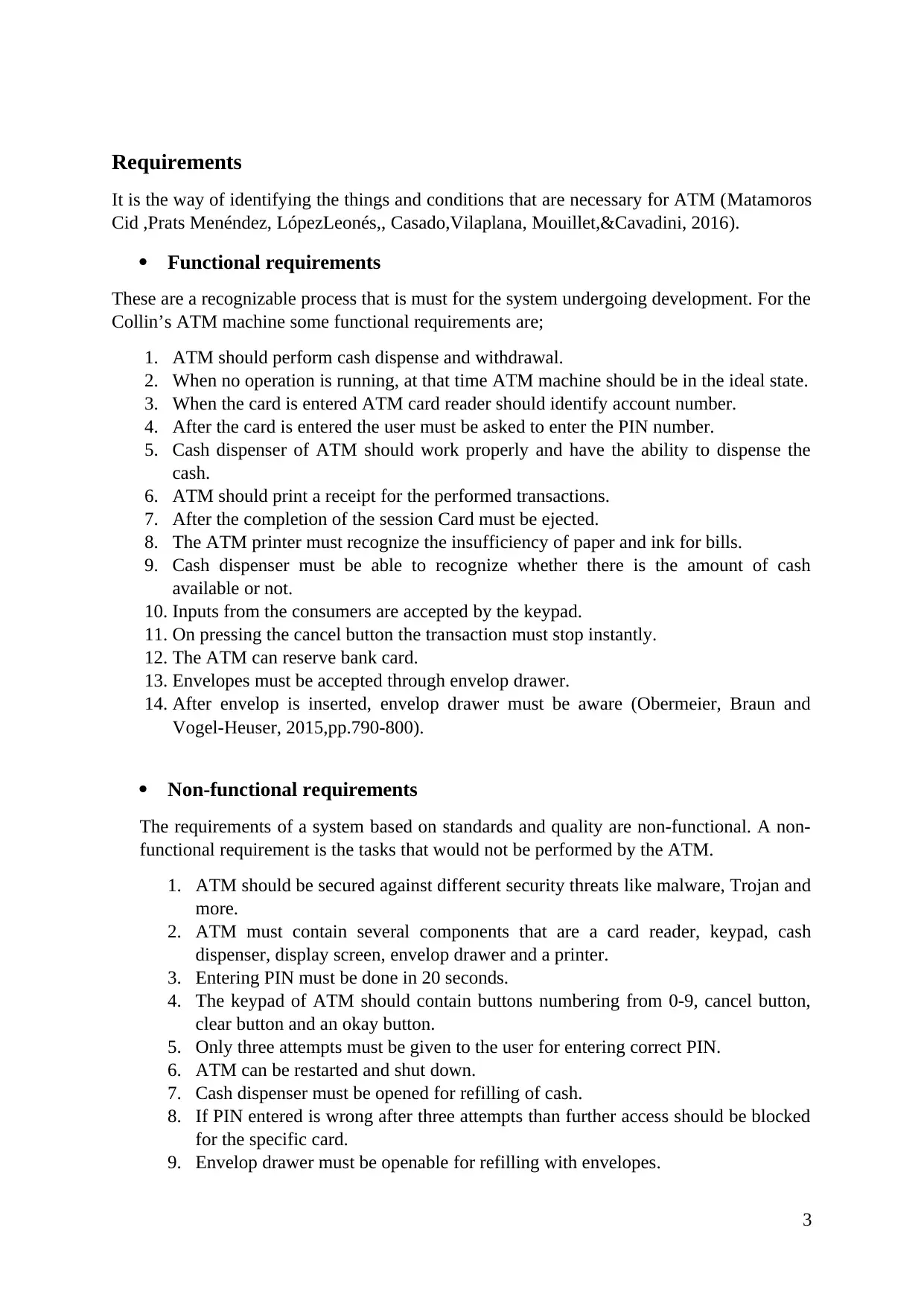
Requirements
It is the way of identifying the things and conditions that are necessary for ATM (Matamoros
Cid ,Prats Menéndez, LópezLeonés,, Casado,Vilaplana, Mouillet,&Cavadini, 2016).
Functional requirements
These are a recognizable process that is must for the system undergoing development. For the
Collin’s ATM machine some functional requirements are;
1. ATM should perform cash dispense and withdrawal.
2. When no operation is running, at that time ATM machine should be in the ideal state.
3. When the card is entered ATM card reader should identify account number.
4. After the card is entered the user must be asked to enter the PIN number.
5. Cash dispenser of ATM should work properly and have the ability to dispense the
cash.
6. ATM should print a receipt for the performed transactions.
7. After the completion of the session Card must be ejected.
8. The ATM printer must recognize the insufficiency of paper and ink for bills.
9. Cash dispenser must be able to recognize whether there is the amount of cash
available or not.
10. Inputs from the consumers are accepted by the keypad.
11. On pressing the cancel button the transaction must stop instantly.
12. The ATM can reserve bank card.
13. Envelopes must be accepted through envelop drawer.
14. After envelop is inserted, envelop drawer must be aware (Obermeier, Braun and
Vogel-Heuser, 2015,pp.790-800).
Non-functional requirements
The requirements of a system based on standards and quality are non-functional. A non-
functional requirement is the tasks that would not be performed by the ATM.
1. ATM should be secured against different security threats like malware, Trojan and
more.
2. ATM must contain several components that are a card reader, keypad, cash
dispenser, display screen, envelop drawer and a printer.
3. Entering PIN must be done in 20 seconds.
4. The keypad of ATM should contain buttons numbering from 0-9, cancel button,
clear button and an okay button.
5. Only three attempts must be given to the user for entering correct PIN.
6. ATM can be restarted and shut down.
7. Cash dispenser must be opened for refilling of cash.
8. If PIN entered is wrong after three attempts than further access should be blocked
for the specific card.
9. Envelop drawer must be openable for refilling with envelopes.
3
It is the way of identifying the things and conditions that are necessary for ATM (Matamoros
Cid ,Prats Menéndez, LópezLeonés,, Casado,Vilaplana, Mouillet,&Cavadini, 2016).
Functional requirements
These are a recognizable process that is must for the system undergoing development. For the
Collin’s ATM machine some functional requirements are;
1. ATM should perform cash dispense and withdrawal.
2. When no operation is running, at that time ATM machine should be in the ideal state.
3. When the card is entered ATM card reader should identify account number.
4. After the card is entered the user must be asked to enter the PIN number.
5. Cash dispenser of ATM should work properly and have the ability to dispense the
cash.
6. ATM should print a receipt for the performed transactions.
7. After the completion of the session Card must be ejected.
8. The ATM printer must recognize the insufficiency of paper and ink for bills.
9. Cash dispenser must be able to recognize whether there is the amount of cash
available or not.
10. Inputs from the consumers are accepted by the keypad.
11. On pressing the cancel button the transaction must stop instantly.
12. The ATM can reserve bank card.
13. Envelopes must be accepted through envelop drawer.
14. After envelop is inserted, envelop drawer must be aware (Obermeier, Braun and
Vogel-Heuser, 2015,pp.790-800).
Non-functional requirements
The requirements of a system based on standards and quality are non-functional. A non-
functional requirement is the tasks that would not be performed by the ATM.
1. ATM should be secured against different security threats like malware, Trojan and
more.
2. ATM must contain several components that are a card reader, keypad, cash
dispenser, display screen, envelop drawer and a printer.
3. Entering PIN must be done in 20 seconds.
4. The keypad of ATM should contain buttons numbering from 0-9, cancel button,
clear button and an okay button.
5. Only three attempts must be given to the user for entering correct PIN.
6. ATM can be restarted and shut down.
7. Cash dispenser must be opened for refilling of cash.
8. If PIN entered is wrong after three attempts than further access should be blocked
for the specific card.
9. Envelop drawer must be openable for refilling with envelopes.
3
Paraphrase This Document
Need a fresh take? Get an instant paraphrase of this document with our AI Paraphraser
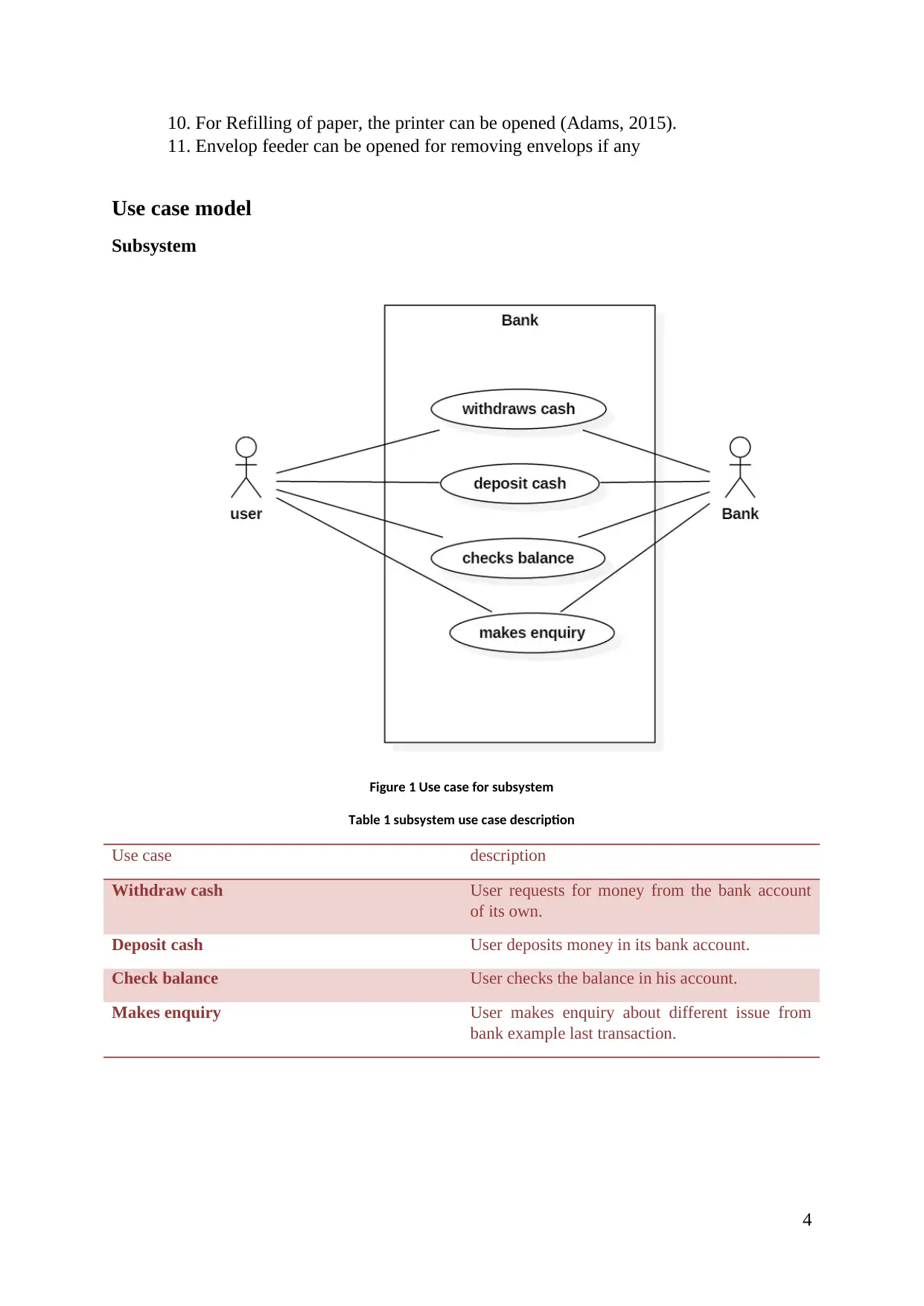
10. For Refilling of paper, the printer can be opened (Adams, 2015).
11. Envelop feeder can be opened for removing envelops if any
Use case model
Subsystem
Figure 1 Use case for subsystem
Table 1 subsystem use case description
Use case description
Withdraw cash User requests for money from the bank account
of its own.
Deposit cash User deposits money in its bank account.
Check balance User checks the balance in his account.
Makes enquiry User makes enquiry about different issue from
bank example last transaction.
4
11. Envelop feeder can be opened for removing envelops if any
Use case model
Subsystem
Figure 1 Use case for subsystem
Table 1 subsystem use case description
Use case description
Withdraw cash User requests for money from the bank account
of its own.
Deposit cash User deposits money in its bank account.
Check balance User checks the balance in his account.
Makes enquiry User makes enquiry about different issue from
bank example last transaction.
4
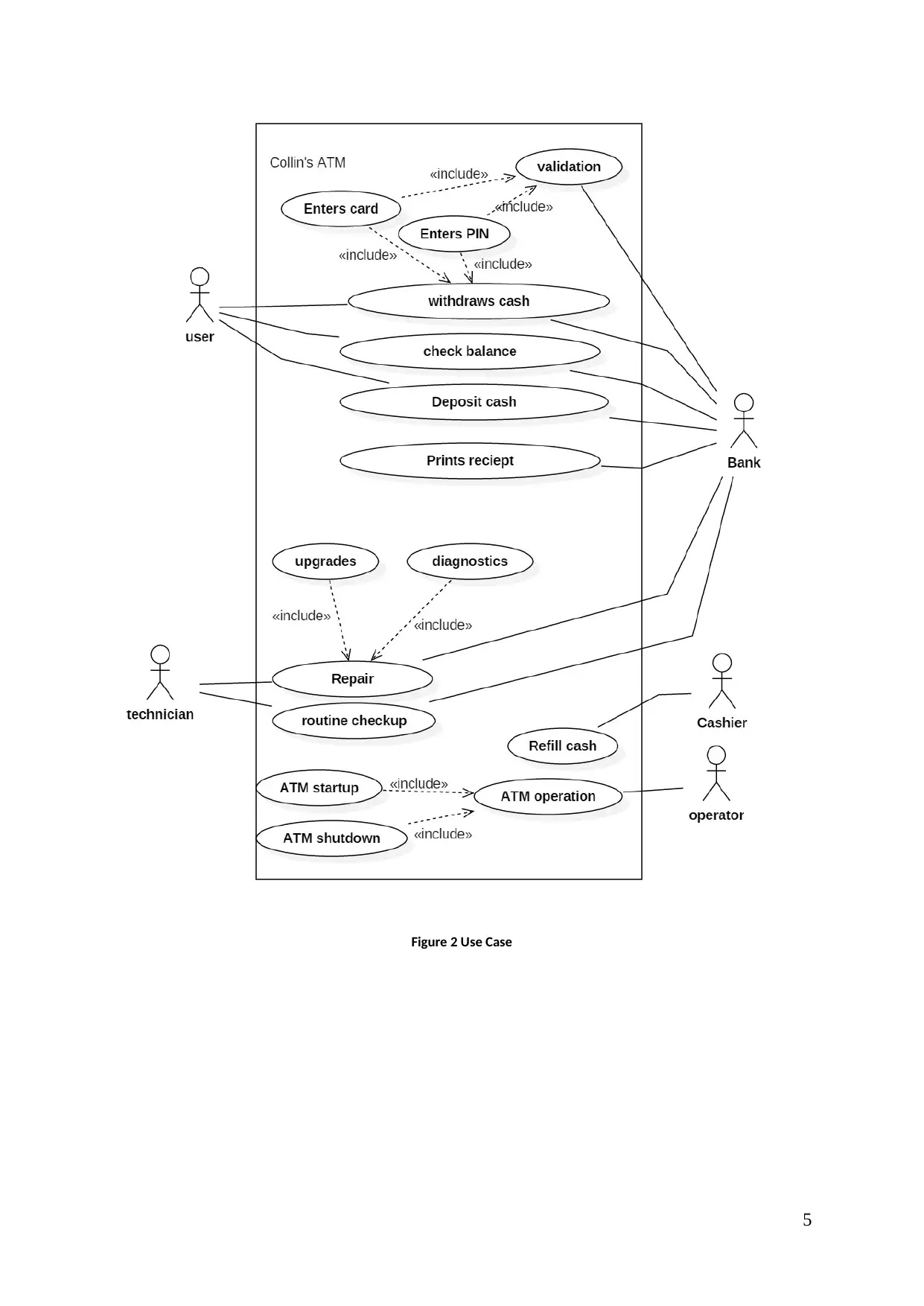
Figure 2 Use Case
5
5
⊘ This is a preview!⊘
Do you want full access?
Subscribe today to unlock all pages.

Trusted by 1+ million students worldwide
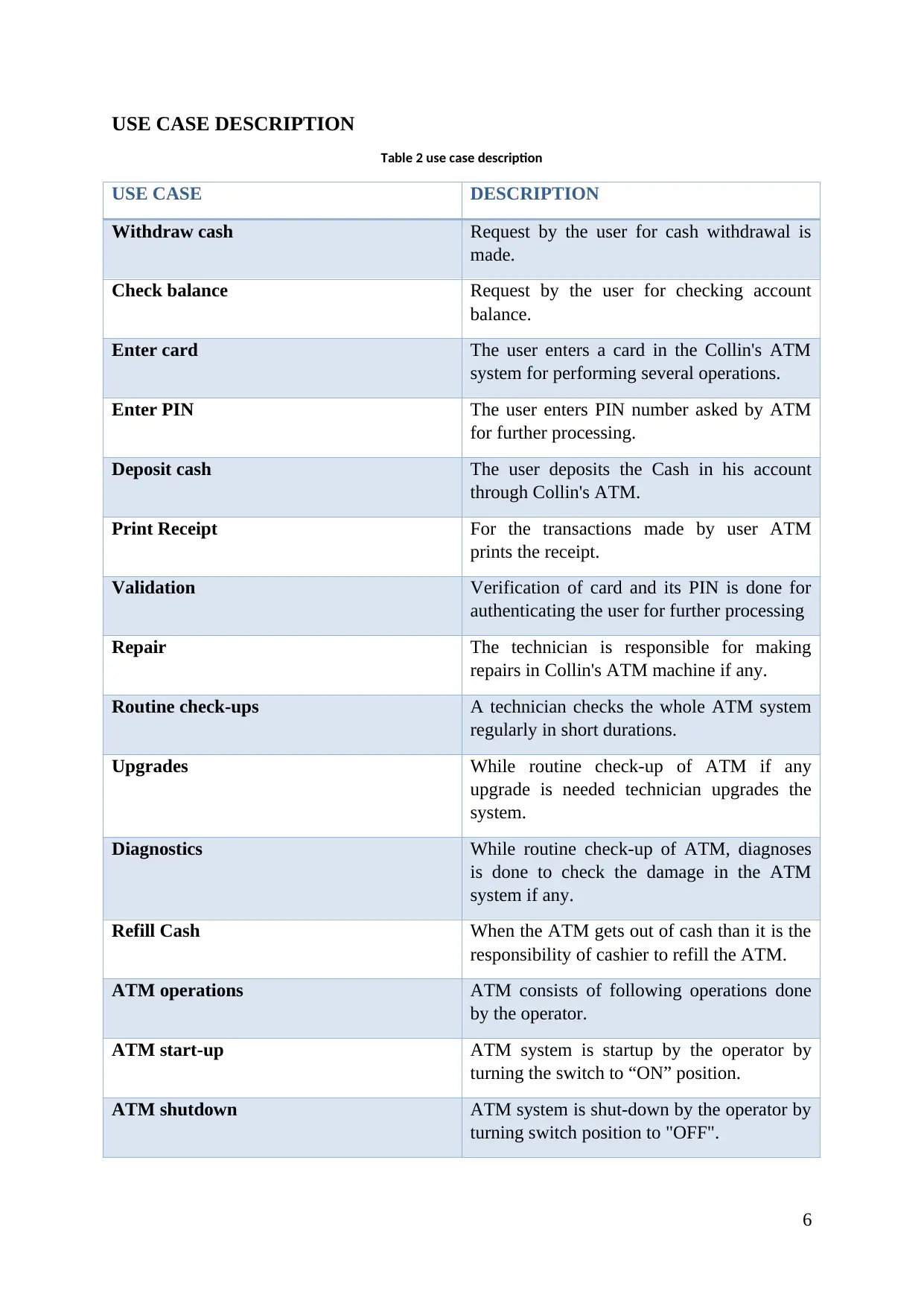
USE CASE DESCRIPTION
Table 2 use case description
USE CASE DESCRIPTION
Withdraw cash Request by the user for cash withdrawal is
made.
Check balance Request by the user for checking account
balance.
Enter card The user enters a card in the Collin's ATM
system for performing several operations.
Enter PIN The user enters PIN number asked by ATM
for further processing.
Deposit cash The user deposits the Cash in his account
through Collin's ATM.
Print Receipt For the transactions made by user ATM
prints the receipt.
Validation Verification of card and its PIN is done for
authenticating the user for further processing
Repair The technician is responsible for making
repairs in Collin's ATM machine if any.
Routine check-ups A technician checks the whole ATM system
regularly in short durations.
Upgrades While routine check-up of ATM if any
upgrade is needed technician upgrades the
system.
Diagnostics While routine check-up of ATM, diagnoses
is done to check the damage in the ATM
system if any.
Refill Cash When the ATM gets out of cash than it is the
responsibility of cashier to refill the ATM.
ATM operations ATM consists of following operations done
by the operator.
ATM start-up ATM system is startup by the operator by
turning the switch to “ON” position.
ATM shutdown ATM system is shut-down by the operator by
turning switch position to "OFF".
6
Table 2 use case description
USE CASE DESCRIPTION
Withdraw cash Request by the user for cash withdrawal is
made.
Check balance Request by the user for checking account
balance.
Enter card The user enters a card in the Collin's ATM
system for performing several operations.
Enter PIN The user enters PIN number asked by ATM
for further processing.
Deposit cash The user deposits the Cash in his account
through Collin's ATM.
Print Receipt For the transactions made by user ATM
prints the receipt.
Validation Verification of card and its PIN is done for
authenticating the user for further processing
Repair The technician is responsible for making
repairs in Collin's ATM machine if any.
Routine check-ups A technician checks the whole ATM system
regularly in short durations.
Upgrades While routine check-up of ATM if any
upgrade is needed technician upgrades the
system.
Diagnostics While routine check-up of ATM, diagnoses
is done to check the damage in the ATM
system if any.
Refill Cash When the ATM gets out of cash than it is the
responsibility of cashier to refill the ATM.
ATM operations ATM consists of following operations done
by the operator.
ATM start-up ATM system is startup by the operator by
turning the switch to “ON” position.
ATM shutdown ATM system is shut-down by the operator by
turning switch position to "OFF".
6
Paraphrase This Document
Need a fresh take? Get an instant paraphrase of this document with our AI Paraphraser
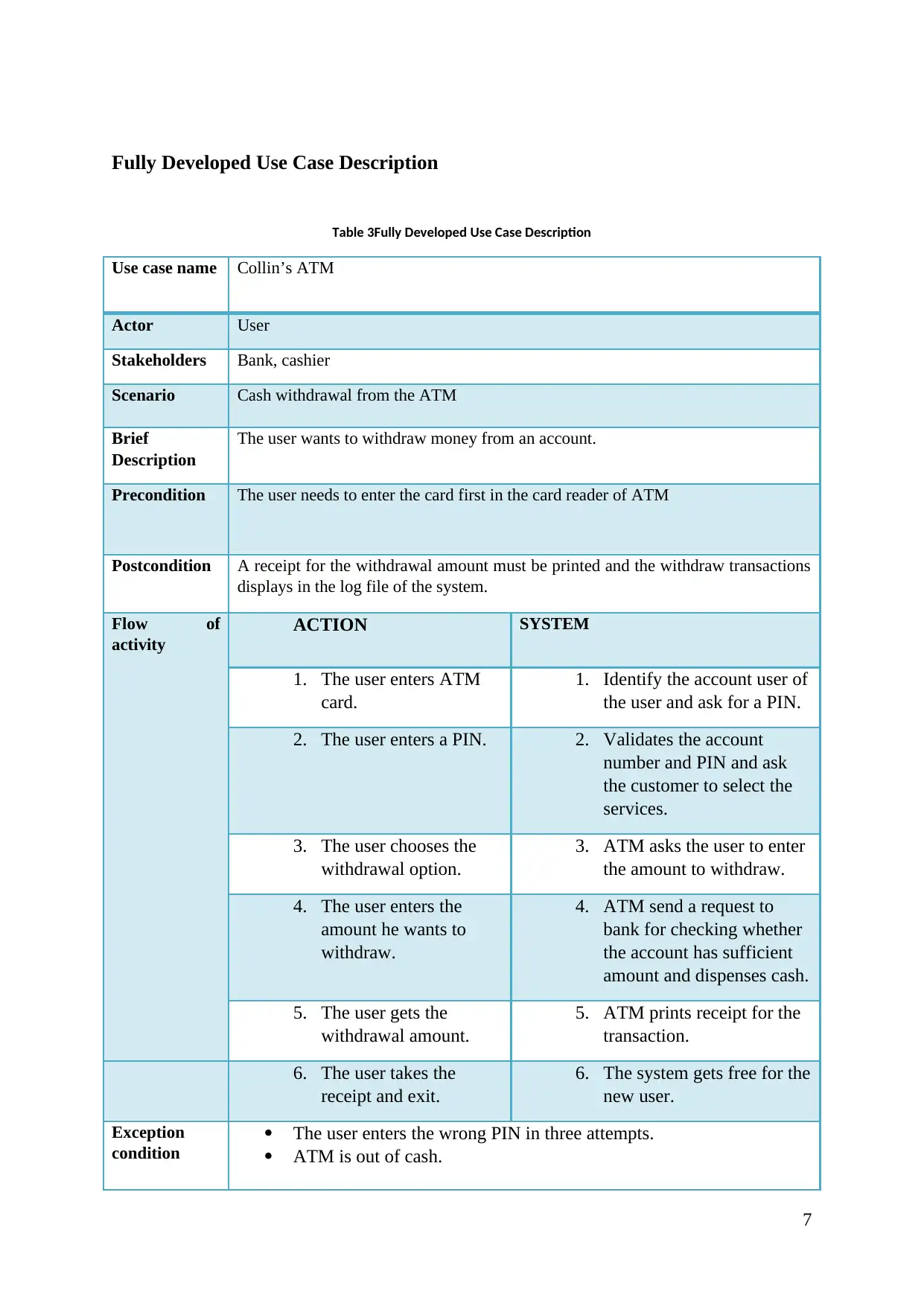
Fully Developed Use Case Description
Table 3Fully Developed Use Case Description
Use case name Collin’s ATM
Actor User
Stakeholders Bank, cashier
Scenario Cash withdrawal from the ATM
Brief
Description
The user wants to withdraw money from an account.
Precondition The user needs to enter the card first in the card reader of ATM
Postcondition A receipt for the withdrawal amount must be printed and the withdraw transactions
displays in the log file of the system.
Flow of
activity
ACTION SYSTEM
1. The user enters ATM
card.
1. Identify the account user of
the user and ask for a PIN.
2. The user enters a PIN. 2. Validates the account
number and PIN and ask
the customer to select the
services.
3. The user chooses the
withdrawal option.
3. ATM asks the user to enter
the amount to withdraw.
4. The user enters the
amount he wants to
withdraw.
4. ATM send a request to
bank for checking whether
the account has sufficient
amount and dispenses cash.
5. The user gets the
withdrawal amount.
5. ATM prints receipt for the
transaction.
6. The user takes the
receipt and exit.
6. The system gets free for the
new user.
Exception
condition
The user enters the wrong PIN in three attempts.
ATM is out of cash.
7
Table 3Fully Developed Use Case Description
Use case name Collin’s ATM
Actor User
Stakeholders Bank, cashier
Scenario Cash withdrawal from the ATM
Brief
Description
The user wants to withdraw money from an account.
Precondition The user needs to enter the card first in the card reader of ATM
Postcondition A receipt for the withdrawal amount must be printed and the withdraw transactions
displays in the log file of the system.
Flow of
activity
ACTION SYSTEM
1. The user enters ATM
card.
1. Identify the account user of
the user and ask for a PIN.
2. The user enters a PIN. 2. Validates the account
number and PIN and ask
the customer to select the
services.
3. The user chooses the
withdrawal option.
3. ATM asks the user to enter
the amount to withdraw.
4. The user enters the
amount he wants to
withdraw.
4. ATM send a request to
bank for checking whether
the account has sufficient
amount and dispenses cash.
5. The user gets the
withdrawal amount.
5. ATM prints receipt for the
transaction.
6. The user takes the
receipt and exit.
6. The system gets free for the
new user.
Exception
condition
The user enters the wrong PIN in three attempts.
ATM is out of cash.
7
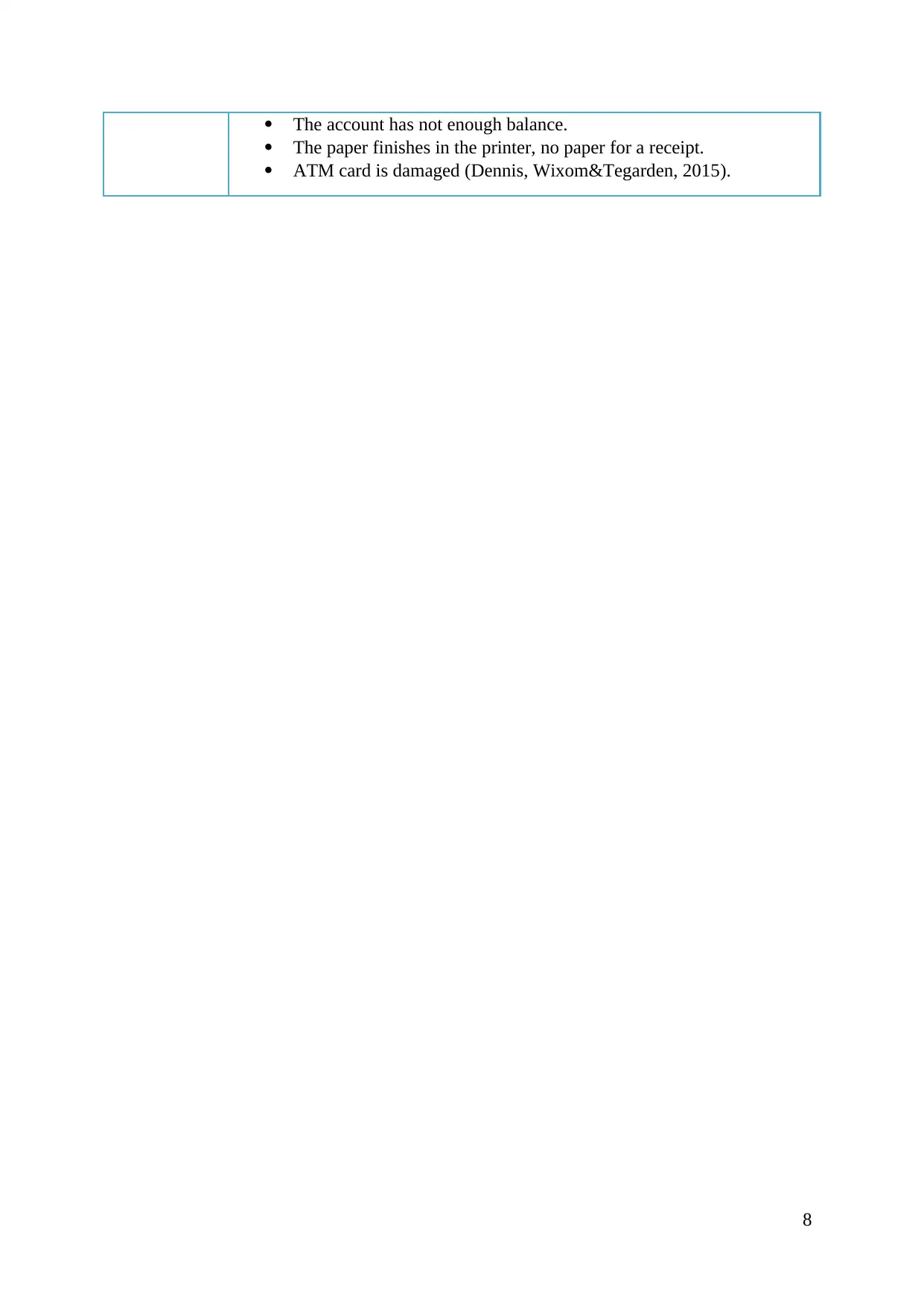
The account has not enough balance.
The paper finishes in the printer, no paper for a receipt.
ATM card is damaged (Dennis, Wixom&Tegarden, 2015).
8
The paper finishes in the printer, no paper for a receipt.
ATM card is damaged (Dennis, Wixom&Tegarden, 2015).
8
⊘ This is a preview!⊘
Do you want full access?
Subscribe today to unlock all pages.

Trusted by 1+ million students worldwide
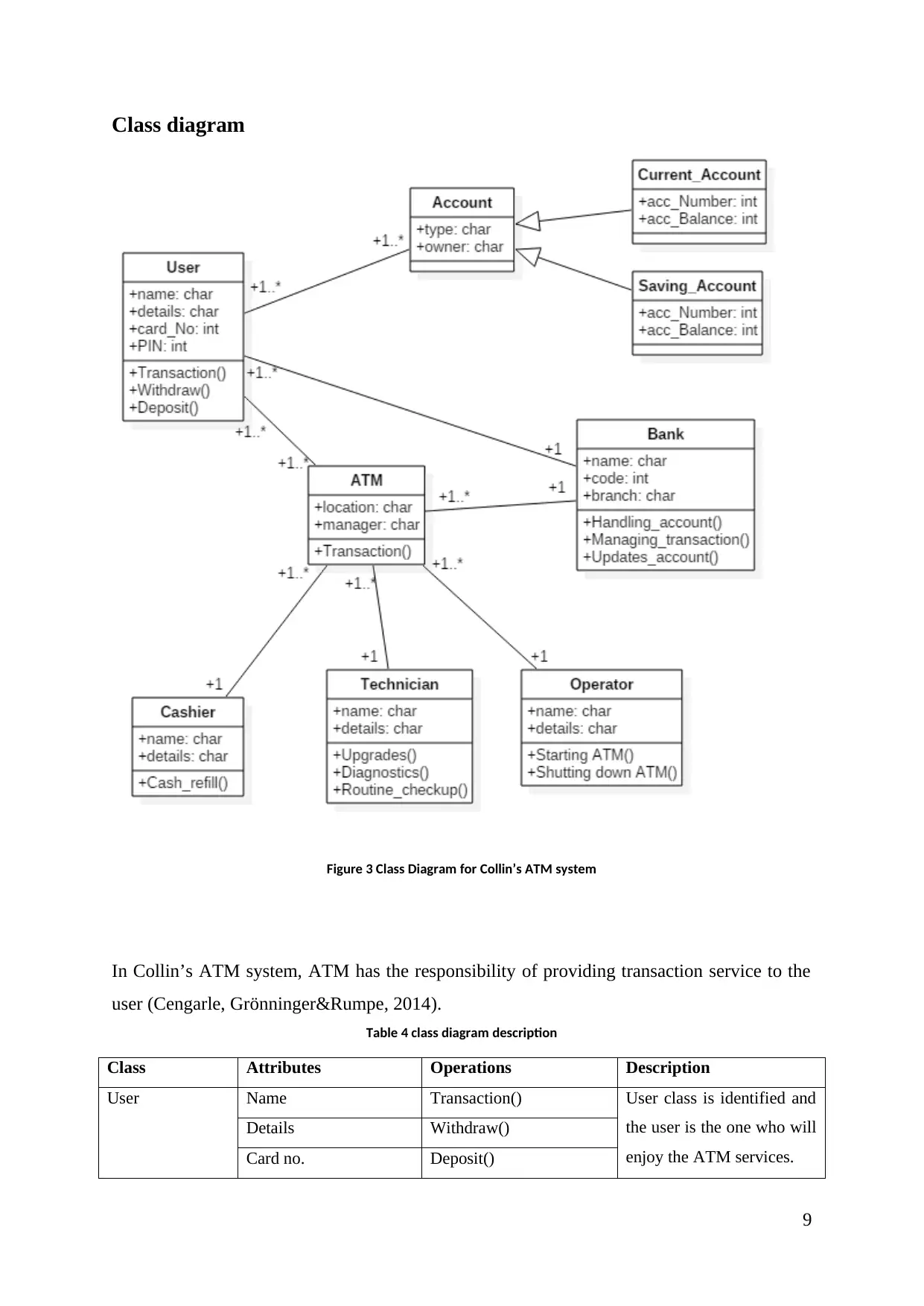
Class diagram
Figure 3 Class Diagram for Collin’s ATM system
In Collin’s ATM system, ATM has the responsibility of providing transaction service to the
user (Cengarle, Grönninger&Rumpe, 2014).
Table 4 class diagram description
Class Attributes Operations Description
User Name Transaction() User class is identified and
the user is the one who will
enjoy the ATM services.
Details Withdraw()
Card no. Deposit()
9
Figure 3 Class Diagram for Collin’s ATM system
In Collin’s ATM system, ATM has the responsibility of providing transaction service to the
user (Cengarle, Grönninger&Rumpe, 2014).
Table 4 class diagram description
Class Attributes Operations Description
User Name Transaction() User class is identified and
the user is the one who will
enjoy the ATM services.
Details Withdraw()
Card no. Deposit()
9
Paraphrase This Document
Need a fresh take? Get an instant paraphrase of this document with our AI Paraphraser
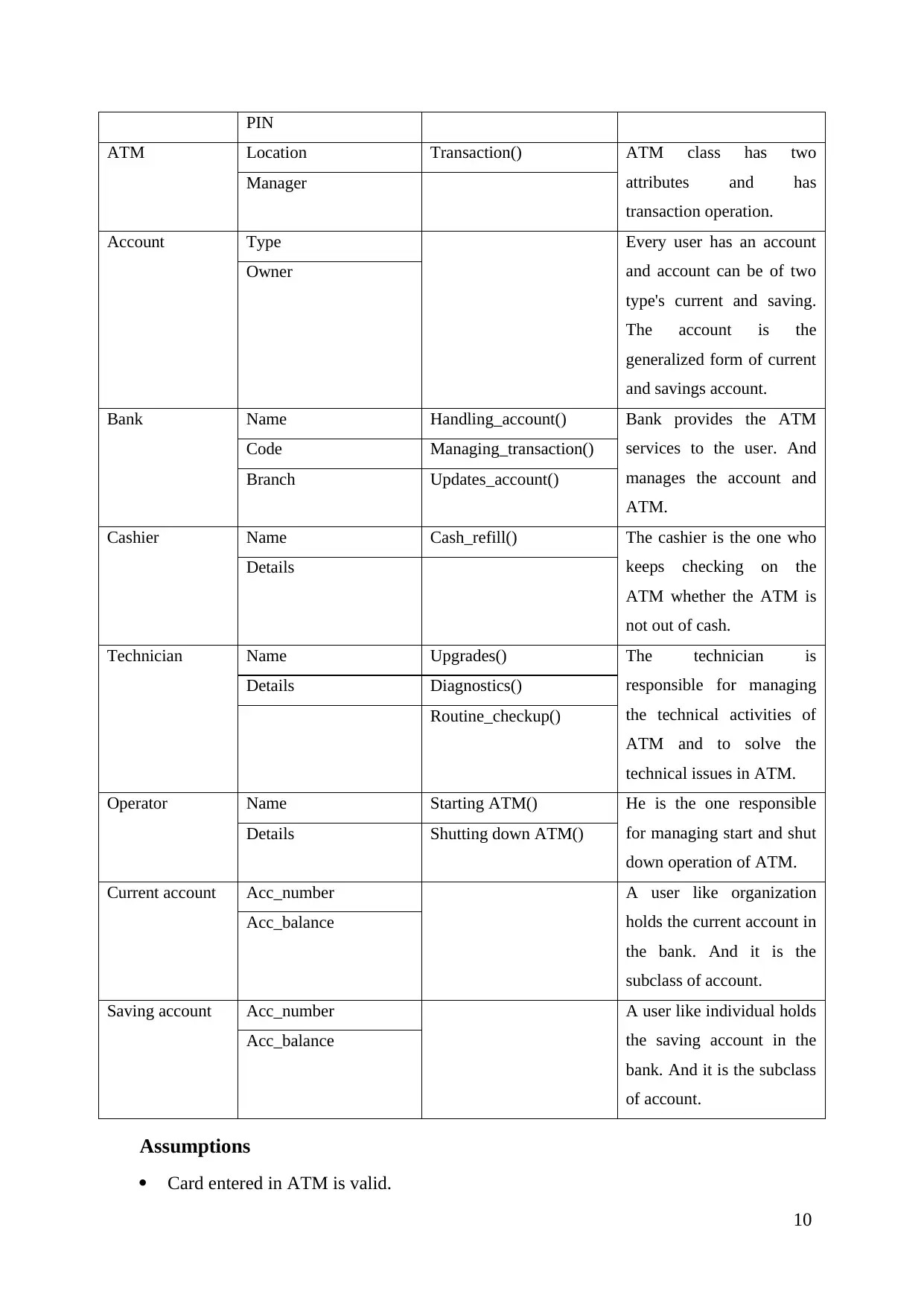
PIN
ATM Location Transaction() ATM class has two
attributes and has
transaction operation.
Manager
Account Type Every user has an account
and account can be of two
type's current and saving.
The account is the
generalized form of current
and savings account.
Owner
Bank Name Handling_account() Bank provides the ATM
services to the user. And
manages the account and
ATM.
Code Managing_transaction()
Branch Updates_account()
Cashier Name Cash_refill() The cashier is the one who
keeps checking on the
ATM whether the ATM is
not out of cash.
Details
Technician Name Upgrades() The technician is
responsible for managing
the technical activities of
ATM and to solve the
technical issues in ATM.
Details Diagnostics()
Routine_checkup()
Operator Name Starting ATM() He is the one responsible
for managing start and shut
down operation of ATM.
Details Shutting down ATM()
Current account Acc_number A user like organization
holds the current account in
the bank. And it is the
subclass of account.
Acc_balance
Saving account Acc_number A user like individual holds
the saving account in the
bank. And it is the subclass
of account.
Acc_balance
Assumptions
Card entered in ATM is valid.
10
ATM Location Transaction() ATM class has two
attributes and has
transaction operation.
Manager
Account Type Every user has an account
and account can be of two
type's current and saving.
The account is the
generalized form of current
and savings account.
Owner
Bank Name Handling_account() Bank provides the ATM
services to the user. And
manages the account and
ATM.
Code Managing_transaction()
Branch Updates_account()
Cashier Name Cash_refill() The cashier is the one who
keeps checking on the
ATM whether the ATM is
not out of cash.
Details
Technician Name Upgrades() The technician is
responsible for managing
the technical activities of
ATM and to solve the
technical issues in ATM.
Details Diagnostics()
Routine_checkup()
Operator Name Starting ATM() He is the one responsible
for managing start and shut
down operation of ATM.
Details Shutting down ATM()
Current account Acc_number A user like organization
holds the current account in
the bank. And it is the
subclass of account.
Acc_balance
Saving account Acc_number A user like individual holds
the saving account in the
bank. And it is the subclass
of account.
Acc_balance
Assumptions
Card entered in ATM is valid.
10
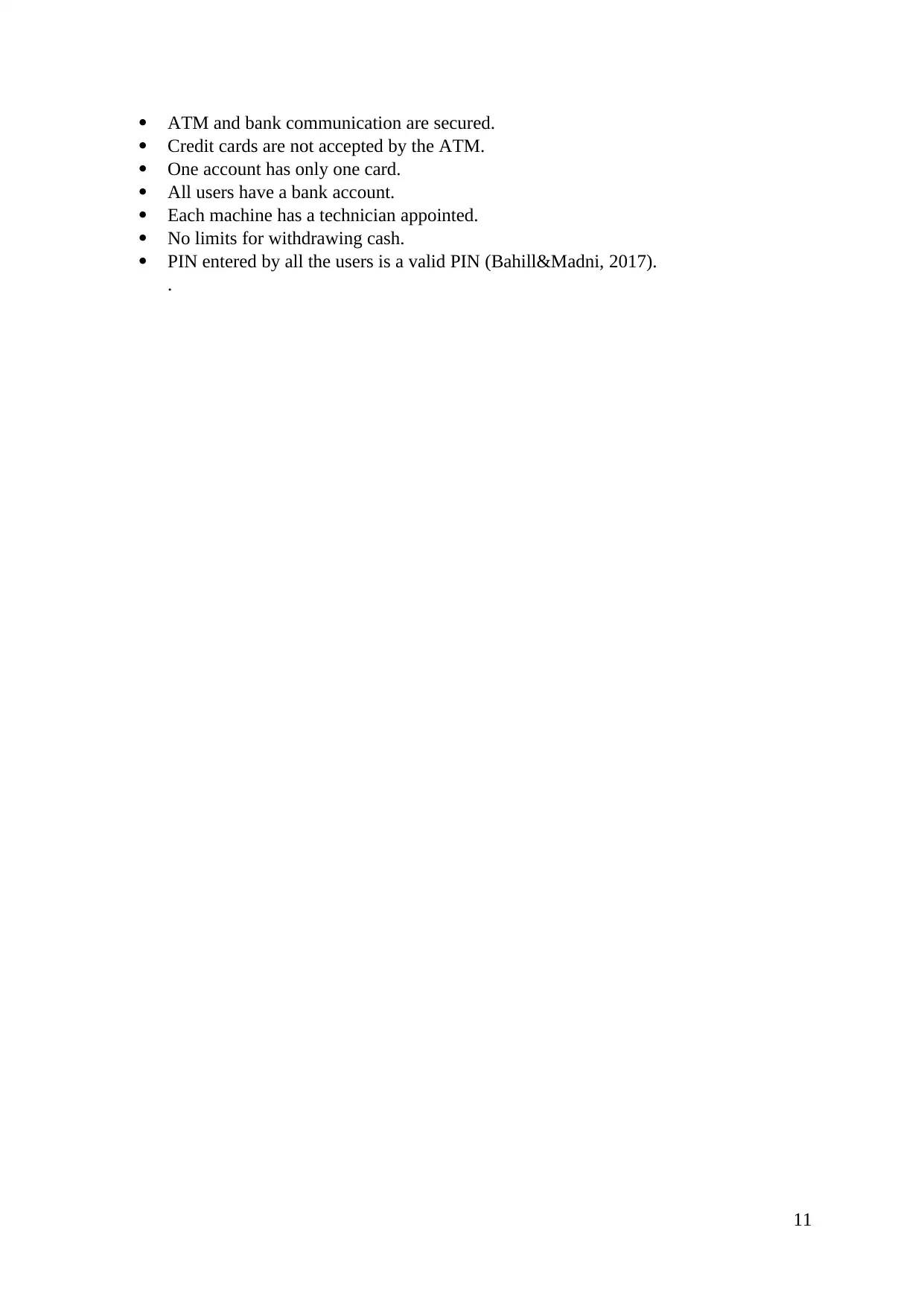
ATM and bank communication are secured.
Credit cards are not accepted by the ATM.
One account has only one card.
All users have a bank account.
Each machine has a technician appointed.
No limits for withdrawing cash.
PIN entered by all the users is a valid PIN (Bahill&Madni, 2017).
.
11
Credit cards are not accepted by the ATM.
One account has only one card.
All users have a bank account.
Each machine has a technician appointed.
No limits for withdrawing cash.
PIN entered by all the users is a valid PIN (Bahill&Madni, 2017).
.
11
⊘ This is a preview!⊘
Do you want full access?
Subscribe today to unlock all pages.

Trusted by 1+ million students worldwide
1 out of 20
Related Documents
Your All-in-One AI-Powered Toolkit for Academic Success.
+13062052269
info@desklib.com
Available 24*7 on WhatsApp / Email
![[object Object]](/_next/static/media/star-bottom.7253800d.svg)
Unlock your academic potential
Copyright © 2020–2025 A2Z Services. All Rights Reserved. Developed and managed by ZUCOL.





